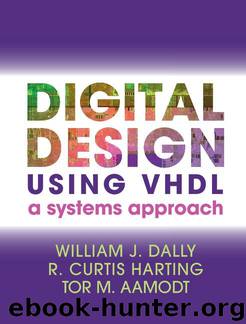Digital Design using VHDL: A Systems Approach by Dally William J. & Harting R. Curtis & Aamodt Tor M

Author:Dally, William J. & Harting, R. Curtis & Aamodt, Tor M.
Language: eng
Format: epub
Publisher: Cambridge University Press
Published: 2015-12-16T16:00:00+00:00
14.1Homing sequences, I. The finite-state machine described by Table 14.2 does not have a reset input. Explain how you can get the machine in a known state regardless of its initial starting state by providing a fixed input sequence. An input sequence that always takes an FSM to the same state is called a homing sequence.
14.2Homing sequences, II. Suppose the traffic-light controller FSM of Table 14.4 did not reset to state GNS. Find a homing sequence for the machine that will get it to state GNS.
14.3Modified traffic-light controller, I-I. Modify the traffic-light controller FSM of Table 14.4 so that it makes lights go red in both directions for one cycle before turning a light green. Show a state table and state diagram for your new FSM.
14.4Modified traffic-light controller, I-II. Choose a state assignment for the modified traffic-light controller of Exercise 14.3 and derive the logic to compute the next-state and output values. Show Karnaugh maps for the next-state variables and output variables and a gate-level schematic for the FSM.
14.5Modified traffic-light controller, I-III. Write and verify the VHDL that implements your state machine from Exercise 14.3.
14.6Modified traffic-light controller, II-I. Modify the traffic-light controller FSM of Table 14.4 so that it takes an additional input, carns, that indicates when there is a car waiting in the north–south direction. Change the logic so that, once the light has changed to east–west, it stays with east–west green until a car waiting in the north–south direction is detected. Show a state table and state diagram for your new FSM.
14.7Modified traffic-light controller, II-II. Choose a state assignment for the modified traffic-light controller of Exercise 14.6 and derive the logic to compute the next-state and output values. Show Karnaugh maps for the next-state variables and output variables and a gate-level schematic for the FSM.
14.8Modified traffic-light controller, II-III. Write and verify the VHDL that implements your state machine from Exercise 14.6.
14.9Modified traffic-light controller, III-I. Modify the traffic-light controller FSM of Table 14.4 so that the FSM stays in state GEW as long as carew is true. Show a state table and state diagram for your new FSM.
14.10Modified traffic-light controller, III-II. Choose a state assignment for the modified traffic-light controller of Exercise 14.9 and derive the logic to compute the next-state and output values. Show Karnaugh maps for the next-state variables and output variables and a gate-level schematic for the FSM.
14.11Modified traffic-light controller, III-III. Write and verify the VHDL that implements your state machine from Exercise 14.9.
14.12Modified pulse filler I. Modify the FSM of Example 14.1 so that it expects pulses on input a every six cycles, rather than five. Draw the state diagram for your modified FSM.
14.13Pulse-filler state table. Write a state table for the FSM of Example 14.1.
14.14Pulse-filler state assignment. Design a state assignment for the pulse-filler FSM of Example 14.1 using three state variables. The R state should have the encoding 000, and state 1 should have the encoding 001. Assign the remaining states so that as few state bits as possible change on each transition.
14.15Pulse-filler implementation.
Download
This site does not store any files on its server. We only index and link to content provided by other sites. Please contact the content providers to delete copyright contents if any and email us, we'll remove relevant links or contents immediately.
| Circuits | Digital Design |
| Electric Machinery & Motors | Electronics |
| Fiber Optics | Networks |
| Superconductivity |
Whiskies Galore by Ian Buxton(41488)
Introduction to Aircraft Design (Cambridge Aerospace Series) by John P. Fielding(32852)
Small Unmanned Fixed-wing Aircraft Design by Andrew J. Keane Andras Sobester James P. Scanlan & András Sóbester & James P. Scanlan(32533)
Craft Beer for the Homebrewer by Michael Agnew(17902)
Turbulence by E. J. Noyes(7659)
The Complete Stick Figure Physics Tutorials by Allen Sarah(7096)
Kaplan MCAT General Chemistry Review by Kaplan(6545)
The Thirst by Nesbo Jo(6405)
Bad Blood by John Carreyrou(6245)
Modelling of Convective Heat and Mass Transfer in Rotating Flows by Igor V. Shevchuk(6200)
Learning SQL by Alan Beaulieu(5994)
Weapons of Math Destruction by Cathy O'Neil(5778)
Man-made Catastrophes and Risk Information Concealment by Dmitry Chernov & Didier Sornette(5585)
Digital Minimalism by Cal Newport;(5319)
Life 3.0: Being Human in the Age of Artificial Intelligence by Tegmark Max(5143)
iGen by Jean M. Twenge(5125)
Secrets of Antigravity Propulsion: Tesla, UFOs, and Classified Aerospace Technology by Ph.D. Paul A. Laviolette(4858)
Design of Trajectory Optimization Approach for Space Maneuver Vehicle Skip Entry Problems by Runqi Chai & Al Savvaris & Antonios Tsourdos & Senchun Chai(4805)
Electronic Devices & Circuits by Jacob Millman & Christos C. Halkias(4698)
